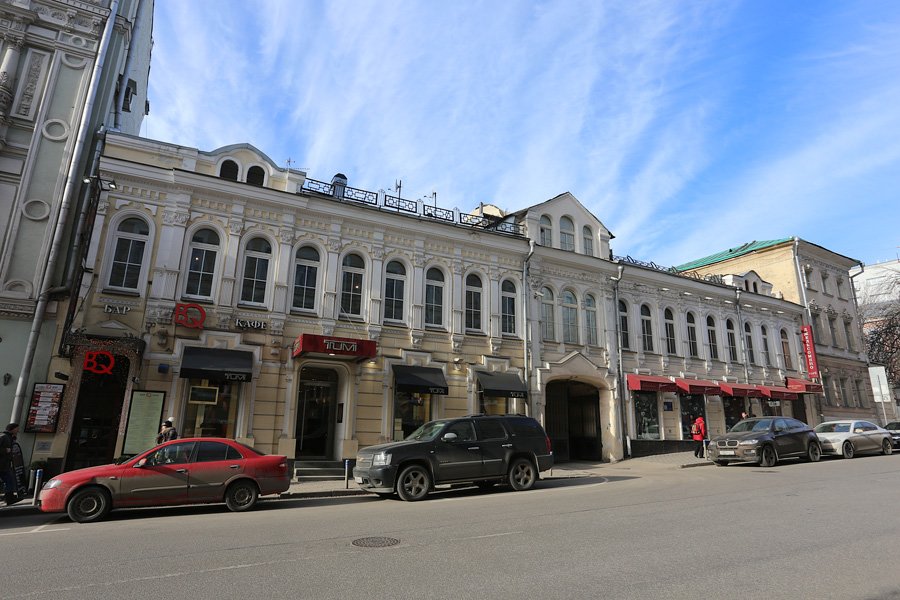Двухэтажный дом 21 по Петровке – прекрасный пример первых доходных домов, начавших появляться в Москве в 1870-х гг. Ранние доходные дома были не выше старинных особняков и гармонично сочетались с усадебными постройками.
В 1730–40-е гг. участок был частью обширного двора сенатора В. Новосильцова, дети которого продали усадьбу А. Некрасову, прадеду знаменитого поэта.
Вдова Некрасова разделила участок на два. Небольшое владение, ставшее сейчас домом 21, принадлежало в разное время московским купцам Шустовым, Шемякиным, Прохоровым, и наконец, Соколовым. В середине XIX в. на Петровку выходили торцы двух двухэтажных домов, украшенные атлантами.
Атланты привлекали посетителей в магазины, расположенные в первых этажах домов, а также были рекламой лепной мастерской Севрюгина, находившейся во дворе.
В одном из помещений дома располагалось «Экипажное заведение Умбрехта».
В 1870-х гг. владельцем дома становится купец 2-й гильдии А. Соколов. В 1876 г. он заказывает проект нового доходного здания архитектору П. Скоморошенко, который построил также дом Троицкого подворья в Китай-городе.
Здесь разместилась фабрика ламп и бронзовых изделий братьев Соколовых, основанная еще в 1848 г. Часть дома занимала футлярная мастерская Иванчикова – Гринберга, известная с 1865 г.
Двухэтажный дом в стиле эклектики, украшенный изящной лепниной и тремя кокошниками на крыше, до сих пор притягивает взгляды прохожих. Массивные чугунные ворота его проездной арки сохранились с момента постройки.
В XIX в. в доме снимали комнаты врачи, работавшие в клинике, расположенной в доме 19. В 1880-х здесь жил профессор фармакологии и терапевт В. Богословский.
В начале 1900 г. часть помещений заняла кулинарная школа.
Соколовы владели домом до революции 1917 г.
В 1920-х в доме жил поэт, писатель, участник Гражданской войны, командир Красной Армии К. Большаков.
The site was part of a vast courtyard of Senator V. Novosiltsov whose children sold the estate of Nekrasov, great-grandfather of the famous poet.
Nekrasov’s widow divided the plot into two sections. Small property, which became house number 21 now, owned by Moscow merchants Shustov, Shemyakin, Prokhorov, and finally, Sokolov at different times. Sides of two two-storey houses decorated with the Atlantes were facing Petrovka in the middle of the XIX century.
Atlantes attracted visitors to the stores located in the ground floors of houses and also served as advertising for Sevryugin’s stucco workshop located in the yard.
"Umbreht’s cartwright institution" was located in one of the premises of the house.
A. Sokolov, the merchant of the 2nd guild becomes home owner in the 1870s. He ordered a new tenement project to the architect P. Skomoroshenko who also built the house of the Trinity Court in Kitay-gorod.
Sokolov brothers’ “lamps and bronze products factory” founded in 1848 was located here.
Ivanchikov-Greenberg case workshop, known since 1865 occupied part of the house.
Two-storey house in an eclectic style, decorated with elegant moldings and three innovative features on the roof, still attracts glances of passers. Massive iron gates of its travel arch are preserved since it was built.
Doctors that were working at the clinic, located in a house 19 rented rooms in the house in the XIX century. V. Bogoslovsky, professor of pharmacology and therapist lived in the house in 1880s.
Culinary school occupied part of the premises at the beginning of 1900.
Sokolovs owned the house until the revolution of 1917.
K. Bolshakov, the poet, writer, participant in the Civil War, the commander of the Red Army lived in the house in the 1920s.












%20BEL_0521.jpg&w=1920&q=75)







